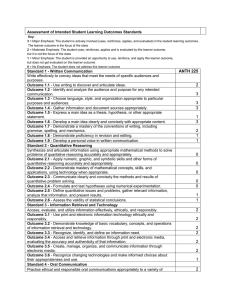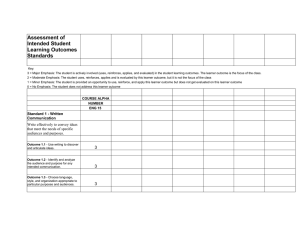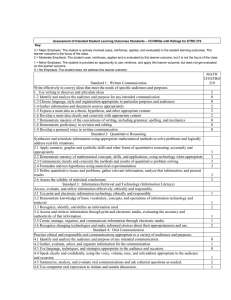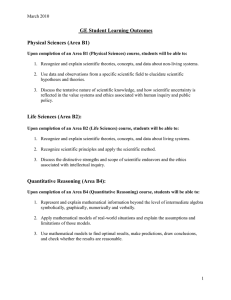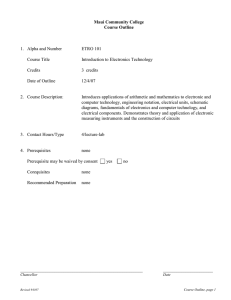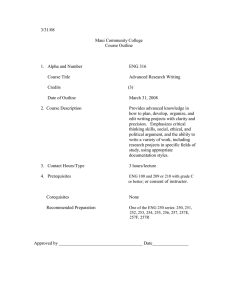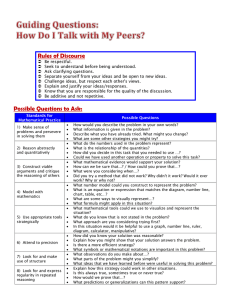1. Alpha and Number MATH 50 Course Title
advertisement
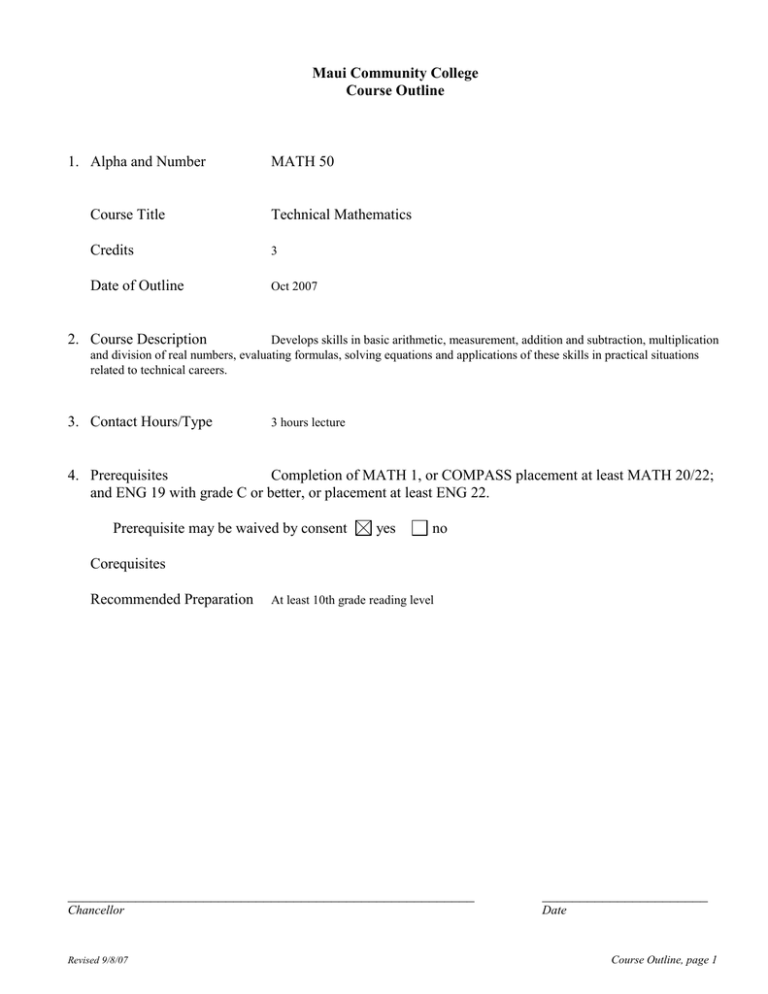
Maui Community College Course Outline 1. Alpha and Number MATH 50 Course Title Technical Mathematics Credits 3 Date of Outline Oct 2007 2. Course Description Develops skills in basic arithmetic, measurement, addition and subtraction, multiplication and division of real numbers, evaluating formulas, solving equations and applications of these skills in practical situations related to technical careers. 3. Contact Hours/Type 3 hours lecture 4. Prerequisites Completion of MATH 1, or COMPASS placement at least MATH 20/22; and ENG 19 with grade C or better, or placement at least ENG 22. Prerequisite may be waived by consent yes no Corequisites Recommended Preparation At least 10th grade reading level ______________________________________________________ ______________________ Chancellor Date Revised 9/8/07 Course Outline, page 1 2 5. General Course Objectives Students successfully completing this course should be able to use the appropriate mathematical skills and tools such as arithmetic operations, algebraic procedures, and calculators to solve problems found in technical careers. 6. Student Learning Outcomes For assessment purposes, link these to #7. Recommended Course Content, and #9. Recommended Course Requirements and Evaluation a. Apply practical mathematics skills needed to solve problems related to trade or technical careers. b. Evaluate appropriate formulas and simple equations in converting between metric and English systems of measurement. c. Apply and interpret percent calculations used solve problems found in technical careers. 7. Recommended Course Content and Approximate Time Spent on Each Topic Link to #6. Student Learning Outcomes a. Calculate mathematical expressions and solve mathematical equations which are used to find solutions to trade or technical situations. (2 to 5 weeks) (a,c) b. Use a scientific calulator, when appropriate, to find mathematical solutions. (1 to 2 weeks) (a,b,c) c. Apply ratios, proportions and percents when appropriate to solve technical problems. (1 to 3 weeks) (a,b,c) d. Use one, two and three dimensional measurements to solve CTE problems. (2 to 4 weeks) (a,b) e. Solve basic algebra problems which include real number solutions to solve equations. (1 to 3 weeks) (a,b,c) f. Solve trade or technical word problems that have applications to real situations. (1 to 4 weeks) (a,b,c) g. Apply geometric properties to solve one, two and three dimensional trade or technical problems. (1 to 3 weeks) (a,b) h. Apply basic trigonometry relationships to solve simulated trade or technical problems. (1 to 3 weeks) (a,b,c) As these topics overlap they all will be worked on throughout the semester and all link the the single student learning outcome for this course. 8. Text and Materials, Reference Materials, Auxiliary Materials, and Content Mathematics for the Trades A Guided Approach by Carman and Saunders 9. Recommended Course Requirements and Evaluation Link to #6. Student Learning Outcomes Course requirements include a 70% mastery of problems included in each exam assessment. 10. Methods of Instruction Self-paced 3 Assessment of Intended Student Learning Outcomes Standards Key: 3 = Major Emphasis: The student is actively involved (uses, reinforces, applies, and evaluated) in the student learning outcomes. The learner outcome is the focus of the class. 2 = Moderate Emphasis: The student uses, reinforces, applies and is evaluated by this learner outcome, but it is not the focus of the class 1 = Minor Emphasis: The student is provided an opportunity to use, reinforce, and apply this learner outcome but does not get evaluated on this learner outcome 0 = No Emphasis: The student does not address this learner outcome Standard 1 - Written Communication Write effectively to convey ideas that meet the needs of specific audiences and purposes. Outcome 1.1 - Use writing to discover and articulate ideas. Outcome 1.2 - Identify and analyze the audience and purpose for any intended communication. Outcome 1.3 - Choose language, style, and organization appropriate to particular purposes and audiences. Outcome 1.4 - Gather information and document sources appropriately. Outcome 1.5 - Express a main idea as a thesis, hypothesis, or other appropriate statement. Outcome 1.6 - Develop a main idea clearly and concisely with appropriate content. Outcome 1.7 - Demonstrate a mastery of the conventions of writing, including grammar, spelling, and mechanics. Outcome 1.8 - Demonstrate proficiency in revision and editing. Outcome 1.9 - Develop a personal voice in written communication. COURSE ALPHA NUMBER MATH 50 1 0 0 0 0 0 0 0 0 Standard 2 - Quantitative Reasoning Synthesize and articulate information using appropriate mathematical methods to solve problems of quantative reasoning accurately and appropriately. Outcome 2.1 - Apply numeric, graphic, and symbolic skills and other forms of quantitative reasoning accurately and appropriately. Outcome 2.2 - Demonstrate mastery of mathematical concepts, skills, and applications, using technology when appropriate. Outcome 2.3 - Communicate clearly and concisely the methods and results of quantitative problem solving. Outcome 2.4 - Formulate and test hypotheses using numerical experimentation. Outcome 2.5 - Define quantitative issues and problems, gather relevant information, analyze that information, and present results. Outcome 2.6 - Assess the validity of statistical conclusions. 3 3 3 2 3 0 Standard 3 - Information Retrieval and Technology Access, evaluate, and utilize information effectively, ethically, and responsibly. Outcome 3.1 - Use print and electronic information technology ethically and responsibly. 2 Outcome 3.2 - Demonstrate knowledge of basic vocabulary, concepts, and operations of information retrieval and technology. 2 1 Outcome 3.3 - Recognize, identify, and define an information need. Outcome 3.4 - Access and retrieve information through print and electronic media, evaluating the accuracy and authenticity of that information. Outcome 3.5 - Create, manage, organize, and communicate information through electronic media. Outcome 3.6 - Recognize changing technologies and make informed choices about their appropriateness and use. Standard 4 - Oral Communication Practice ethical and responsible oral communications appropriately to a variety of audiences and purposes. 1 0 0 4 Outcome 4.1 - Identify and analyze the audience and purpose of any intended communication. Outcome 4.2 - Gather, evaluate, select, and organize information for the communication. Outcome 4.3 - Use language, techniques, and strategies appropriate to the audience and occasion. Outcome 4.4 - Speak clearly and confidently, using the voice, volume, tone, and articulation appropriate to the audience and occasion. Outcome 4.5 - Summarize, analyze, and evaluate oral communications and ask coherent questions as needed. Outcome 4.6 - Use competent oral expression to initiate and sustain discussions. 0 0 0 0 1 1 Standard 5 - Critical Thinking Apply critical thinking skills to effectively address the challenges and solve problems. Outcome 5.3 - Formulate research questions that require descriptive and explanatory analyses. 3 2 0 Outcome 5.4 - Recognize and understand multiple modes of inquiry, including investigative methods based on observation and analysis. 0 Outcome 5.1 - Identify and state problems, issues, arguments, and questions contained in a body of information. Outcome 5.2 - Identify and analyze assumptions and underlying points of view relating to an issue or problem. Outcome 5.5 - Evaluate a problem, distinguishing between relevant and irrelevant facts, opinions, assumptions, issues, values, and biases through the use of appropriate evidence. Outcome 5.8 - Communicate clearly and concisely the methods and results of logical reasoning. 2 3 1 2 Outcome 5.9 - Reflect upon and evaluate their thought processes, value system, and world views in comparison to those of others. 0 Outcome 5.6 - Apply problem-solving techniques and skills, including the rules of logic and logical sequence. Outcome 5.7 - Synthesize information from various sources, drawing appropriate conclusions.
